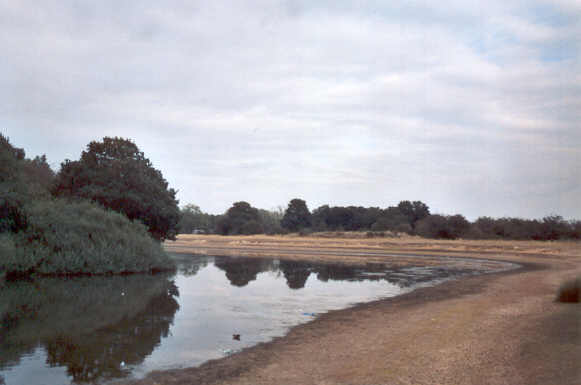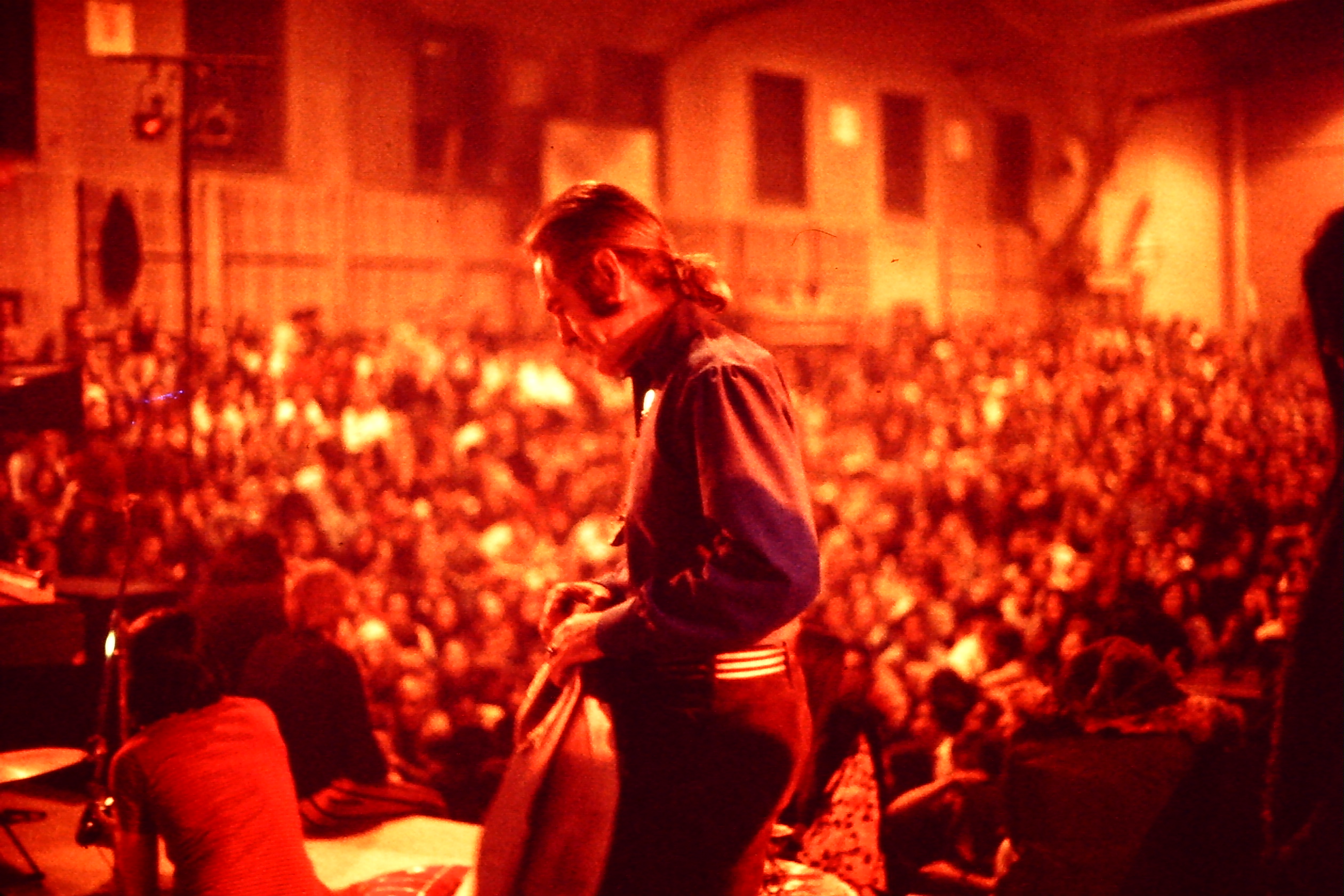|
Flanger
Flanging is an audio effect produced by mixing two identical signals together, one signal delayed by a small and (usually) gradually changing period, usually smaller than 20 milliseconds. This produces a swept comb filter effect: peaks and notches are produced in the resulting frequency spectrum, related to each other in a linear harmonic series. Varying the time delay causes these to sweep up and down the frequency spectrum. A flanger is an effects unit that creates this effect. Part of the output signal is usually fed back to the input (a re-circulating delay line), producing a resonance effect that further enhances the intensity of the peaks and troughs. The phase of the fed-back signal is sometimes inverted, producing another variation on the flanger sound. Origin As an audio effect, a listener hears a ''drainpipe'' or ''swoosh'' or ''jet plane'' sweeping effect as shifting sum-and-difference harmonics are created analogous to use of a variable notch filter. The term ... [...More Info...] [...Related Items...] OR: [Wikipedia] [Google] [Baidu] |
Effects Unit
An effects unit, effects processor, or effects pedal is an electronic device that alters the sound of a musical instrument or other audio source through audio signal processing. Common effects include distortion (music), distortion/overdrive, often used with electric guitar in electric blues and rock music; dynamics (music), dynamic effects such as volume pedals and Dynamic range compression, compressors, which affect loudness; linear filter, filters such as wah-wah pedals and graphic equalizers, which modify frequency ranges; modulation effects, such as Chorus (audio effect), chorus, flangers and phaser (effect), phasers; Pitch (music), pitch effects such as pitch shifter (audio processor), pitch shifters; and time effects, such as Reverb effect, reverb and Delay (audio effect), delay, which create echoing sounds and emulate the sound of different spaces. Most modern effects use solid-state electronics or digital signal processors. Some effects, particularly older ones such a ... [...More Info...] [...Related Items...] OR: [Wikipedia] [Google] [Baidu] |
Audio Signal Processing
Audio signal processing is a subfield of signal processing that is concerned with the electronic manipulation of audio signals. Audio signals are electronic representations of sound waves—longitudinal waves which travel through air, consisting of compressions and rarefactions. The energy contained in audio signals or sound power level is typically measured in decibels. As audio signals may be represented in either Digital signal (signal processing), digital or analog signal, analog format, processing may occur in either domain. Analog processors operate directly on the electrical signal, while digital processors operate mathematically on its digital representation. History The motivation for audio signal processing began at the beginning of the 20th century with inventions like the telephone, phonograph, and radio that allowed for the transmission and storage of audio signals. Audio processing was necessary for early radio broadcasting, as there were many problems with stud ... [...More Info...] [...Related Items...] OR: [Wikipedia] [Google] [Baidu] |
Automatic Double Tracking
Automatic double-tracking or artificial double-tracking (ADT) is an analogue recording technique designed to enhance the sound of voices or instruments during the mixing process. It uses Delay (audio effect), tape delay to create a delayed copy of an audio signal which is then played back at slightly varying speed controlled by an oscillator and combined with the original. The effect is intended to simulate the sound of the natural doubling of voices or instruments achieved by double tracking. The technique was developed in 1966 by Recording engineer, engineers at Abbey Road Studios in LondonMartin, George, ''All You Need Is Ears'', St. Martin's Press, 1979, p. 155, . at the request of the Beatles. Background As early as the 1950s, it was discovered that double-tracking the lead vocal in a song gave it a richer, more appealing sound, especially for singers with weak or light voices. Use of this technique became possible with the advent of magnetic tape for use in sound recordin ... [...More Info...] [...Related Items...] OR: [Wikipedia] [Google] [Baidu] |
The Big Hurt (song)
"The Big Hurt" is a pop song that was a hit for Toni Fisher (billed as "Miss Toni Fisher") in 1959. The song was written by Wayne Shanklin. "The Big Hurt" is notable because it featured phasing effects which at that time were rare in popular music; DJ Dick Biondi on WKBW would introduce the record as "Toni Fisher's weird one." Music The 45 rpm single plays in C major, even though on the sheet music (copyright 1959 by Music Productions, Hollywood, CA), the song is in the key of F major. The time signature is 4/4, and the tempo is indicated as "Moderate Beguine Tempo." The melody begins with a triplet on beats three and four, a motif that appears throughout the song in every second measure. In the other measures, however, the duple meter is reinforced by using eighth notes in the same location, presumably to prevent the tune from becoming a waltz.Piano-vocal score (Hollywood, CA: Music Productions, 1959). Although Toni Fisher does use the triplet in her performance on the reco ... [...More Info...] [...Related Items...] OR: [Wikipedia] [Google] [Baidu] |
Glyn Johns
Glyn Thomas Johns (born 15 February 1942) is an English recording engineer and record producer. He has worked with many of the most famous rock recording acts from both the UK and abroad, such as the Rolling Stones, the Beatles, the Who, Led Zeppelin, the Kinks, Eagles, Bob Dylan, the Band, Eric Clapton, the Clash, Steve Miller Band, Small Faces, the Ozark Mountain Daredevils and Joan Armatrading. Throughout his career, he has generally preferred a live, natural approach to recording in the studio, and developed a method of recording drums sometimes referred to as the " Glyn Johns method". The years 1964–1984 marked Johns's peak era of activity in which he engineered or produced numerous hit records. In 1965 Johns became one of the first independent British recording engineers to operate freelance rather than under the hire of a particular record label or studio. He was involved in making some of the most influential albums of the rock era such as '' Beggars Banquet'' ... [...More Info...] [...Related Items...] OR: [Wikipedia] [Google] [Baidu] |
Itchycoo Park
"Itchycoo Park" is a song by English rock band Small Faces, written by Steve Marriott and Ronnie Lane. Largely written by Lane, it was among a number of pop songs of the era to make use of flanging, an effect involving, at that time, electro-mechanical processes. The song was not included on any of their UK albums, but was however featured on the North American release ''There Are But Four Small Faces'' (1968). Released on 4 August 1967 by Immediate Records, the song was Small Faces' fifth top-ten song in the UK Singles Chart, reaching a position of number three. "Itchycoo Park" became the Small Faces' sole top-forty hit in the United States, reaching number sixteen on the US Billboard Hot 100, ''Billboard'' Hot 100 in early 1968. In Continental Europe, it reached the top ten in several countries, while in Canada and New Zealand it was a number one hit. The single was re-released in December 1975, reaching number nine in the UK Singles chart, and is often attributed as the reason ... [...More Info...] [...Related Items...] OR: [Wikipedia] [Google] [Baidu] |
The Small Faces
Small Faces were an English rock band from London, founded in 1965. The group originally consisted of Steve Marriott, Ronnie Lane, Kenney Jones and Jimmy Winston, with Ian McLagan replacing Winston as the band's keyboardist in 1966. The band were one of the most acclaimed and influential mod groups of the 1960s, recording hit songs such as "Itchycoo Park", " Lazy Sunday", " All or Nothing" and "Tin Soldier", as well as their concept album '' Ogdens' Nut Gone Flake''. They evolved into one of the UK's most successful psychedelic bands until 1969. When Marriott left to form Humble Pie, the remaining three members collaborated with Ronnie Wood, Wood's older brother Art Wood, Rod Stewart and Kim Gardner, briefly continuing under the name Quiet Melon, and then, with the departure of Art Wood and Gardner, as the Faces. In North America, the Faces' debut album was credited to Small Faces. Following the breakup of both the Faces and Humble Pie in 1975, the classic line-up of ... [...More Info...] [...Related Items...] OR: [Wikipedia] [Google] [Baidu] |
Barnes, London
Barnes () is a district in South West London, England, part of the London Borough of Richmond upon Thames. It takes up the extreme north-east of the borough, and as such is the closest part of the borough to central London. It is centred west south-west of Charing Cross in a bend of the River Thames. Its built environment includes a wide variety of convenience and arts shopping on its high street and a high proportion of 18th- and 19th-century buildings in the streets near Barnes Pond. Together they make up the Barnes Village conservation area where, along with its west riverside, pictured, most of the mid-19th-century properties are concentrated. On the east riverside is the WWT London Wetland Centre adjoining Barn Elms playing fields. Barnes has retained woodland on the "Barnes Trail", a short circular walk taking in the riverside, commercial streets and conservation area, including the Olympic Studios. The trail is marked by silver discs set in the ground and with QR-co ... [...More Info...] [...Related Items...] OR: [Wikipedia] [Google] [Baidu] |
Olympic Studios
Olympic Studios was a British independent recording studio based on Church Road, Barnes, Church Road, Barnes, London, Barnes, London. It is best known for its recordings of many artists throughout the late 1960s to the first decade of the 21st century, including Jimi Hendrix, the Beatles, the Rolling Stones, David Bowie, Marc Bolan, Led Zeppelin, Ella Fitzgerald, Queen (band), Queen, Ray Charles, the Who, B. B. King, Traffic (band), Traffic, Prince (musician), Prince, Eagles (band), the Eagles, Eric Clapton, Family (band), Family, Adele, Björk and MIKA (singer), MIKA. It is often regarded as being as significant as Abbey Road Studios, and remains an important cultural landmark. The studio's sound mixing desks became famous when the technology and design they pioneered was manufactured commercially. Although much of Olympic has returned to its original purpose as a cinema, it also still maintains a small recording facility, designed with the help of original members of the studi ... [...More Info...] [...Related Items...] OR: [Wikipedia] [Google] [Baidu] |
George Chkiantz
George Chkiantz is a British recording engineer, based in London, who has been responsible for the engineering on a number of well-known albums, many of which are considered classics, owing in part to the quality of the recordings. Career Chkiantz was the recording engineer of the Small Faces self-titled second album (1967), recorded for Andrew Loog Oldham's Immediate Records label. Chkiantz was a staff engineer at Olympic Studios at the same time that the Jimi Hendrix Experience was recording '' Axis: Bold As Love''. During the session with the Small Faces, Chkiantz engineered the song "Green Circles", which represented the first use of mono flanging on a pop record; he subsequently perfected the technique on their landmark 1967 single "Itchycoo Park". Upon hearing the result, Jimi Hendrix and his engineer, Eddie Kramer applied Chkiantz's concepts, creating stereo phasing on the songs "Bold As Love" and "Little Wing". Deciding to utilize his abilities more fully, Hendrix h ... [...More Info...] [...Related Items...] OR: [Wikipedia] [Google] [Baidu] |
Revolver (Beatles Album)
''Revolver'' is the seventh studio album by the English Rock music, rock band the Beatles. It was released on 5 August 1966, accompanied by the double A-side single "Eleanor Rigby" / "Yellow Submarine (song), Yellow Submarine". The album was the Beatles' final recording project before their retirement as live performers and marked the group's most overt use of studio technology to date, building on the advances of their late 1965 release ''Rubber Soul''. It has since become regarded as one of the greatest and most innovative albums in the history of popular music, with recognition centred on its range of musical styles, diverse sounds and lyrical content. The Beatles recorded ''Revolver'' after taking a three-month break at the start of 1966, and during a period when London was feted as Swinging London, the era's cultural capital. Regarded by some commentators as the start of the group's Psychedelic music, psychedelic period, the songs reflect their interest in the drug Lysergi ... [...More Info...] [...Related Items...] OR: [Wikipedia] [Google] [Baidu] |
Tomorrow Never Knows
"Tomorrow Never Knows" is a song by the English rock band the Beatles, written primarily by John Lennon and credited to Lennon–McCartney. It was released in August 1966 as the final track on their album ''Revolver'', although it was the first song recorded for the LP. The song marked a radical departure for the Beatles, as the band fully embraced the potential of the recording studio without consideration for reproducing the results in concert. When writing the song, Lennon drew inspiration from his experiences with the hallucinogenic drug LSD and from the 1964 book '' The Psychedelic Experience: A Manual Based on the Tibetan Book of the Dead'' by Timothy Leary, Richard Alpert and Ralph Metzner. The Beatles' recording employed musical elements foreign to pop music, including musique concrète, avant-garde composition and electro-acoustic sound manipulation. It features an Indian-inspired modal backing of tambura and sitar drone and bass guitar, with minimal harmonic ... [...More Info...] [...Related Items...] OR: [Wikipedia] [Google] [Baidu] |




